The Bagpipe Society
Bagpiping – Always in the margins?
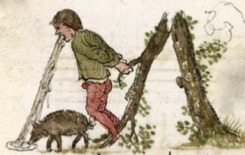
Many(1) people know the Luttrell Psalter bagpiper(2) . He tends to be reproduced on mediaeval greeting cards and T shirts, and to be invoked when anyone says “Oh, not just Scottish, then?”. His depiction is quite detailed, his pipes convincing (even if his hands are, from modern perspective, the wrong way round), and his manner a little shifty.
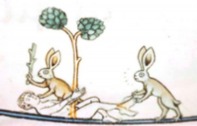
Similar figures appear in the margins of other mediaeval manuscripts, often contrasting with the solemn sacred texts on the pages, often weird or grotesque, and frequently rude or overtly sexual. How and why such odd or filthy images come from the pens of monks remains a fascinating mystery. These drawings are called Grotesques, or Marginal Drolleries. Amongst the violent rabbits (3) , sphincter-exposing monks (4) and penis-riding virgins (5) , are a surprising number of bagpipes. These are often played by skeletons, or by animals such as pigs or bears, and resemble those better-known images carved on to misericords and ceiling bosses. I am not going to try to convince anyone that they are accurate reproductions of real bagpipes, but they suggest that the modern attitude of general wariness of bagpipes may have a very long history. Bagpipes, associating with ideas that are clearly grotesque, are themselves seen as grotesque.
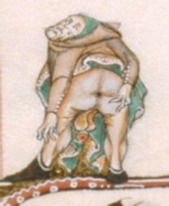
Before Gutenberg’s invention of printing allowed mass production of text, writing was preserved or disseminated by scribes, normally monks, who laboriously copied from one page to another. This was an expensive and slow business, and meant that few people had books, other than the church and the rich. Many of the texts had religious content. As well as the text, manuscripts often had illustrations or decorations. These provided a commentary on the text (pictures of David in psalters for example), or elaborately decorated initial letters to draw the eye to the beginning of a text, a section or a paragraph. These helped the reader to identify where to start to read, or to pause. Illustrations were often very intricate, made by complicated means, with the scribes often having to fabricate their own inks and pens.
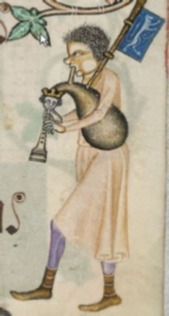
Colours were often highlighted by the addition of gold or silver leaf. Thus one can imagine they were hugely expensive, available to order rather than to retail, and likely to be commissioned by a rich patron. The third feature was the inclusion of other little pictures, known as marginal drolleries, sometimes in the margins around the text, sometimes incorporated into the decorations, such as the initials and the lines framing the text. These were completely different from the serious text or pictures. They were not in line with the message of the text; indeed they could be seen as subverting the text by showing some of the more biological parts of life which we nowadays prefer to keep hidden – depictions of sexual acts, of excretory functions and of fantastic beasts. Among these were frequent depictions of musicians, including bagpipers(6) . These are often played by beasts, fantastic or down-to-earth(7\ &\ 8) .
We are used to seeing bagpipers carved into mediaeval cathedral ceiling bosses (Winchester, Lincoln) misericords (Ripon) or pew ends (Altarnun, Davidstow). These may or may not be accurate representations. Ripon’s is played by a pig, so probably isn’t. They are often accompanied by more whimsical images such as animals or skeletons, so the context in which they were designed appears to our modern eyes to be more fantastical, even subversive. So in the manuscripts, images of rabbits(9) , monkeys(10) , or even an isolated backside(11) playing the bagpipes may be more surprising to our eyes than our predecessors. Incidentally, rabbits are portrayed frequently, bagpiping or not. This may have something to do with their famous fecundity, but their furriness and habit of making burrows, as well as their old name of coney, were taken as suggestive of female genitalia(12) .
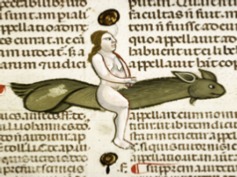
All of which is intriguing fun, but leaves a host of unanswered questions.
Why were these pictures done? They are not doodles. Doodles exist, but have none of the precision and detail drolleries have. Some are gilded(13) , so presumably the person paying for the gold knew of their presence and approved. Thus they were unlikely simply to be the musings of a monk with a celibacy problem.
Given that most books were intended to be read aloud (bibles and psalters for example), the drolleries were visible to the reader alone, not heard by the audience. Why? Why was it cost-effective to have these pictures incorporated into a commissioned book? They are hideously expensive to produce. Who benefitted?
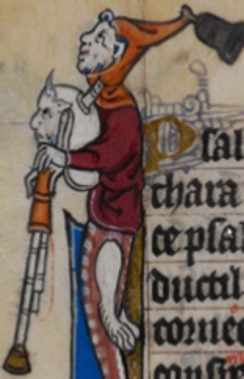
Music was a common theme, possibly because of its known subversive effects (e.g. morris dancing (14) , composition of masses based on popular song (15) . Why did they want to encourage subversion in church? Or is our expectation of cosiness from church too 21st century?
What is it about bagpipes? Some pictures emphasise the genital appearance of bagpipes(16) or bagpipe-playing animals, but most just portray bagpipes in a context we expect to find funny. Bagpipes as an object of ridicule, then as now. Why?
Such questions will never actually be answered, but it gives a fascinating glimpse into how some of our ancestors viewed bagpipes, and meanwhile an unlimited supply of fun and conjecture. Google “marginal drolleries bagpipes” and treat yourself to hours of delight.
References:
1: initial ’M’ chansonnier, Bruges 1542 Cambrai.
2: British Library.
3: Jon Kaneko-James http://bit.ly/Chanter50
4: Gorelston Psalter, British Library. f.
5: Bodlean Library. Douce 5 roll 208 H
6: Pierpont Morgan Library, Book of Hours.
7: Rutland Psalter, British Library.
8: Tres Riches Heures du Duc de Berry, Conde Museum, Chantilly, France.
9: Lyon, Bibliothèque municipale, Ms 5128, fol. 100R
10: The Morgan Library & Museum, New York.
11: Morgan Library & Museum, New York
12: Jon Kaneko-James.
13: Ruskin Hours; Getty Ms. Ludwig IX 3; SV Francie ca 1300; f. 89r
14: The Independent http://bit.ly/Chanter51
16: Book of Hours, Use of Rome (the ‘Hours of Joanna I of Castile’ or the ‘Hours of Joanna the Mad’) Add MS 18852 Folio
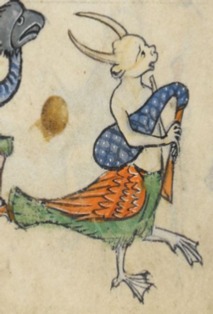
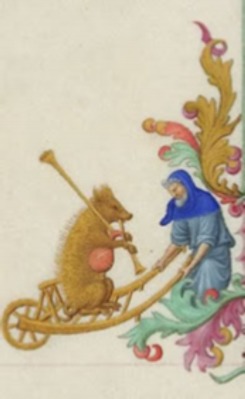
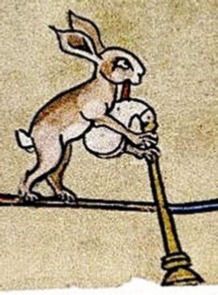
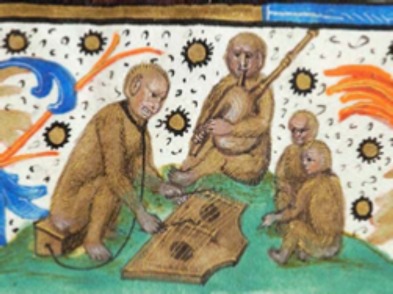
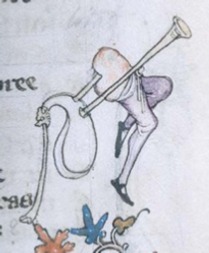
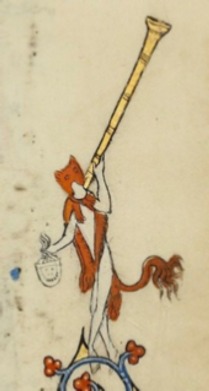
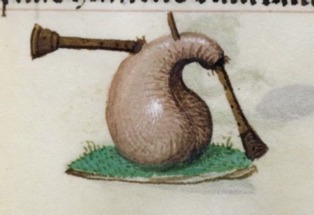
From Chanter Autumn 2018.
- Data Processing Notice (GDPR)
-
@BagpipeSociety on X (formally known as Twitter)
-
TheBagpipeSociety on Instagram
-
 BagpipeSociety on Facebook
BagpipeSociety on Facebook
Something wrong or missing from this page? Let us know!
